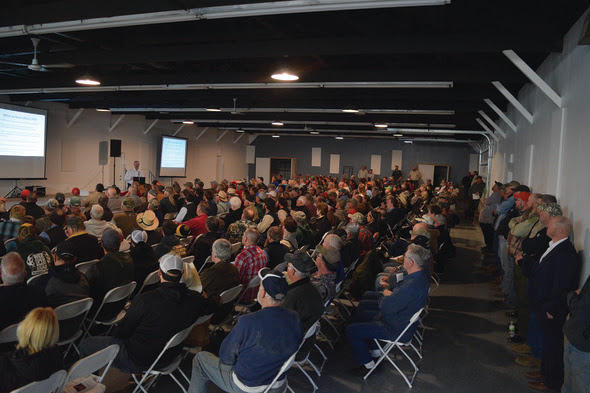
Nearly 300 people filled the 4H Building at the Wayne County Fairgrounds March 15 to learn more about chronic wasting disease (CWD) after a hunter harvested wild deer from last December’s first shotgun season tested positive the always fatal disease. It was the first wild deer to test positive outside northeast Iowa. CWD only affects deer and is confirmed in every state around Iowa. Photo courtesy of the Iowa DNR.
|
Corydon, Iowa - They began arriving nearly an hour before the meeting started and by 6:30 p.m. nearly 300 people filled the 4H building at Wayne County Fairgrounds in Corydon to learn more about chronic wasting disease and what it means now that it has been found here in a wild deer taken during first shotgun season Dec. 4.
Deer hunting is important to residents of Wayne County. It is also important to hunters from more than 400 different towns in Iowa and across the country who harvested a deer in this county on the Missouri border.
Chuck Gipp, director of the Iowa Department of Natural Resources (DNR), set the tone for the meeting by thanking those who came.
“Your attendance at this meeting tonight is evidence of your passion for deer hunting and we’re here to ask for your help to fight a fatal disease,” Gipp said.
Chronic wasting disease is an always fatal disease that affects deer, elk, moose, caribou and reindeer. It is caused by a misshapen protein called a prion that can live for years in the environment, where it can re-infect deer long after the source is gone. It is spread through urine, blood and saliva from infected deer and directly by deer to deer contact.
Terry Haindfield, wildlife biologist for the Iowa DNR who is coordinating the state’s effort to monitor for the disease, provided an update on the history of the disease in Iowa, its progression in surrounding states and answered dozens of questions from the audience well past the meeting’s 8 p.m. conclusion.
“The bottom line is we are going to tackle this disease together. We need help from you to provide tissue samples for testing, especially in those early seasons. Those are local deer and the most important for our monitoring effort before the shotgun seasons start and the deer start moving around,” he said.
“A common concern we hear from hunters is that we are going to shoot all the deer to wipe out the disease and the answer is no, we are not going to shoot all the deer. We are using tools available to manage this disease in partnership with you, the hunters and landowners. We need you to provide additional deer tissue samples from deer that you are already harvesting that will help us to get a better handle on the extent that it is on the landscape,” Haindfield said.
He told the audience they can also help by not moving the deer carcass to a new area or leave it on the landscape and report any sick-looking deer to the local conservation officer or area wildlife biologist.
“We know we have one positive deer in Wayne County,” Haindfield said. “One big thing you can do to help slow the spread is to remove any feed or mineral sites from the landscape, remove the soil from around the site and replace it with soil that does not have any residual minerals in it. These artificially concentrate deer creating hot spots that can really accelerate the rate of disease transmission.
“Our goal is to try to slow the spread of chronic wasting disease to allow science an opportunity to develop more tools to help us in this fight,” he said. “We want you to keep hunting. Deer hunting is an important family tradition and working together we can provide this great tradition for our grandchildren and their grandchildren.”
Media Contact: Terry Haindfield, Wildlife Biologist, Iowa Department of Natural Resources, 563-546-7960.